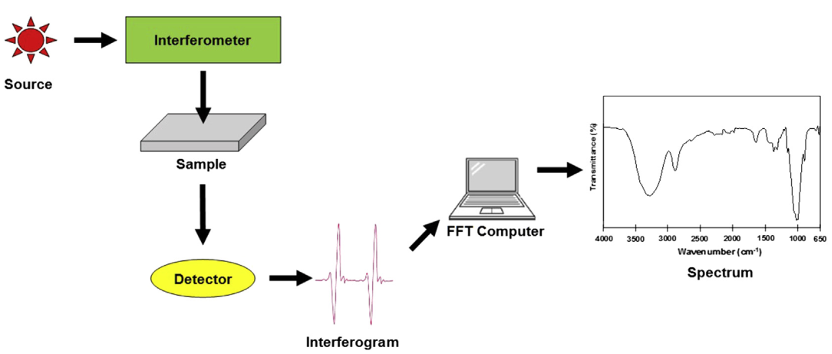Fourier Transform Infrared Spectroscopy (FTIR) Service
FTIR is a form of vibrational spectroscopy that identifies organic or inorganic materials by measuring the absorption of infrared radiation. When a molecule is excited into a higher vibrational state by absorbed IR radiation, the wavelength absorbed is a function of the energy difference between the at-rest and excited vibrational states. It also matches the molecular components and structures.
In an FTIR system, a beam of IR irradiation is emitted from a glowing black-body source. Subsequently, the beam passes through the interferometer where the spectral encoding takes place. The recombination of the beams with different path lengths in the interferometer creates constructive and destructive interference, referred to as an interferogram. The beam now enters the sample compartment, and the sample absorbs specific frequencies of energy, which are uniquely characteristic of the sample from the interferogram. Then, the detector measures the special interferogram signal in energy versus time for all frequencies simultaneously. In the meantime, a beam is superimposed to provide a reference (background) for the instrument operation. Finally, the desirable spectrum was obtained after the interferogram automatically subtracted the spectrum of the background from the sample spectrum by Fourier transformation computer software.
 Figure
1. The basic component in FTIR spectrometer
Figure
1. The basic component in FTIR spectrometer
FTIR has several advantages over other spectroscopy techniques:
- Multiplex or Felgett Advantage that collects all wavelengths from Near InfraRed (NIR) to Far InfraRed (FIR) spectra simultaneously.
- Jacquinot Advantage does not require slits to achieve resolution and much higher throughput.
- Excellent in capturing weak signals with high spectral accuracy.
- Non-destructive and accommodate large-size samples.
FTIR could be applied in multiple fields:
- Chemistry and materials: identify and characterize components.
- Pharmaceuticals: analyze packaging coatings, screen quality of materials.
- Food: detect food additives.
- Environmental safety: determine and monitor the contaminant content.
- Biological: analyze the tissue or cell architecture.
Creative Biostructure provides excellent FTIR services with leading technology, a professional team, high standards of ethical conduct and integrity. Please feel free to contact us for more information.
Ordering Process
Reference
- Mohamed M A, et al. Fourier transform infrared (FTIR) spectroscopy. Membrane Characterization. Elsevier. 2017: 3-29.
